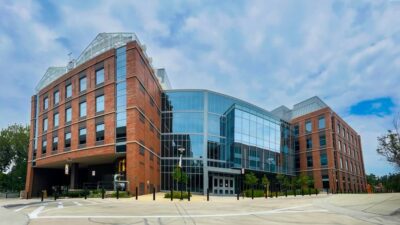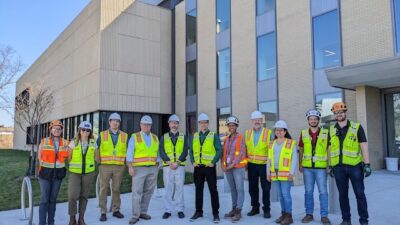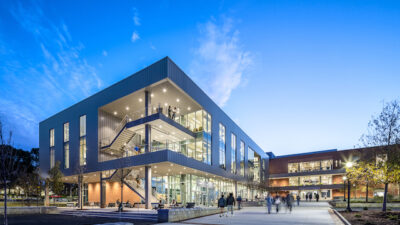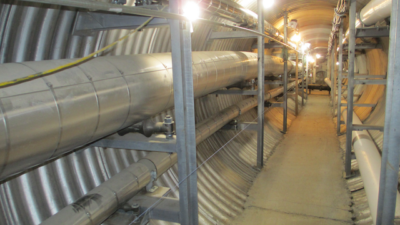With increasingly complex systems and technology coming into play, work on modern K-12 projects is anything but elementary
Respondents
Doug Everhart, Henderson Engineers
As a vice president and K-12 practice director, Everhart leads a team of education experts. With more than a decade of experience, his specialty involves designing innovative learning environments for students and teachers that use the spaces.
Anna Gradishar, Arup
As an Associate Fire Protection Engineer, Gradishar combines her fire protection and first responder backgrounds to offer expertise to owners, facility managers, tenants and design teams. She has developed comprehensive fire protection and life safety approaches for numerous building types and occupancies.
Keith Hammelman, CannonDesign
In his role as senior vice president, Hammelman focuses on the design and construction of pre-K-12 facilities, serving as the lead mechanical engineer for the firm’s central region. His sustainable project approach goes beyond the best mechanical system to the systemwide integration throughout an entire building.
David Lowrey, Boulder Fire Rescue
Lowrey has served with Boulder Fire Rescue for more than 20 years. He oversees the Community Risk Reduction Division, including code enforcement, building construction, life safety education and fire investigations.
Robert N. Roop, Peter Basso Associates
As principal and market leader for the company’s PBA’s K-12 Schools Group, Roop has spent more than half of his 32-year career exclusively designing educational facilities. He acts as the firm’s primary mechanical engineering technical resource for K-12 school projects.
Engiell Tomaj, Stantec
Tomaj first joined the company in 2012, first as associate, then promoted to principal and Business Center Discipline Leader. He holds an electrical engineering degree as well as an MBA.
Michael L. Younts, Dewberry
Serving as electrical engineer, Younts has been with the firm for more than 13 years. His expertise includes LEED projects, educational facilities and other areas.
CSE: What’s the biggest trend in K-12 projects?
Doug Everhart: Adaptability and experiential learning seem to be common trending terms in today’s K-12 construction climate as learning spaces are becoming multifunctional. Instead of creating various spaces for a single long-term function, schools are now incorporating learning spaces that can serve the needs of a rapidly changing curriculum that responds to a rapidly changing world of careers.
Educators and districts are expressing a need for openness to various ways in which students learn. Educators are seeing a need to incorporate aspects of modern working environments into learning environments. This helps future-proof with adaptable spaces that can be repurposed as the landscape of educational environments and learning techniques evolve. Students and educators are mobile and need the freedom to adjust the space to suit the current need. This adaptability needs to be carefully planned in design of building systems and technology infrastructure to support future flexibility and mobility in an ever-changing world.
Keith Hammelman: The biggest trend we continue to see is the use of technology in the learning environment, along with collaborative learning. With this trend we are seeing that many of our clients integrate the school’s information technology department into the design process at earlier stages to ensure that the building design meets the needs of the students of the future.
David Lowrey: I would have to say it’s the security at the schools and its relationship with the other life safety design of the school. I do not mean this in a negative connotation — actually the opposite. We know that we need to provide multiple levels of safety from different threats in our school and I have seen the different engineering disciplines come together to ensure all level of safety is met. The other trend is simply the design of the schools: much more elaborate, interactive and open for the occupants. Not the typical school many of us attended growing up.
Robert N. Roop: One of the major trends we’ve seen in our geographical area is the emergence of stand-alone early childhood education centers operated by public school systems. We’ve been involved in the construction of several such facilities in the last three to four years and are currently working on the design of several more.
Engiell Tomaj: The biggest trend I’m seeing is that more and more school districts are interested in renewable energy (photovoltaics) and getting to net zero energy. They are looking for ways to cut maintenance and operation cost by incorporating cost-saving technologies such as PV on a project. As a result, we have built a financial modeling tool that estimates simple and discounted payback using money from fund balance and from bonds sold.
In Texas, some wealthier school districts are known as “Chapter 41 districts” and are required to send money collected from property taxes back to the state. This process is known as recapture. I have seen districts with recapture as high as 65%. For example, a school district would need to collect $300,000 from local property taxes to pay a $105,000 electric bill. If we were to reduce an electric bill by $105,000 by designing a zero net energy school, we would save taxpayers $300,000 annually or give them the opportunity to put those dollars to work in the classroom.
Michael L. Younts: We have seen an increase in demand for collaborative spaces in schools outside of the traditional classroom setting. Teaching trends are continuing to look at ways to instruct students in multiple ways to engage them in their individual, preferred method of instruction. The end goal is to effectively reach more students, more effectively. Building systems (especially technology) must evolve with this trend to provide more effective and engaging teaching spaces.
CSE: What future trends should engineers and designers expect for such projects?
Anna Gradishar: Design that supports flexibility in use and ever-increasing access to technology. Classrooms today are primarily paperless. Children are using computers in kindergarten as classroom learning aids, so the dependency on wireless technology will only grow.
Tomaj: In addition to renewable energy such as PV, I believe other future trends may include wireless lighting control devices/control, circadian or tunable lighting, building automation via machine learning and the “internet of things.” Further, power over Ethernet to power LED lighting and other building system will continue to make a push for more market share.
Lowrey: This might not be a trend for engineers and designers, but the schools are changing the way they teach or deliver the programs. They want more open spaces, interaction and collaboration among classes. Demand for new/different technology in the classrooms as well as throughout the school is a must in most new and remodeled schools.
Hammelman: We are seeing that with the integration of technology further into the operation of schools that engineers and designers will need to be further versed in IT infrastructure. We are also seeing that in larger school districts, the facilities group and the IT group is merging together, with many of the building systems now managed by the IT department with support from the facilities department.
Roop: Due to the success of this type of facility and the likelihood that students who start in an early childhood program in a district will remain in that district rather than chose another option, we expect this trend to continue.
Everhart: We should expect an integration of all building systems and IoT-based technology that allows learning environments to be monitored and precisely tuned based on end-user trends and resulting student performance. Because both user-level content within the classroom and building systems are now directly interfacing with technology, this creates tremendous potential for the synergy of systems to be responsive to each individual in the learning environment for increased performance.
CSE: What types of challenges do you encounter for these types of projects that you might not face on other types of structures?
Tomaj: Schools are designed to be around for the next 50+ years. I have worked with dozens of school districts in my career and one of the benefits is, if you serve these districts well, you develop long-term relationships and a repeat client. This means you are vested in long-term solutions that go beyond your typical contract period.
In my experience, there can be big skill disparities between districts’ facilities and maintenance personnel. Some districts have experienced and skilled maintenance staff who are willing to explore and learn new technologies, but others do not. Some districts have a full maintenance staff and the resources to maintain a building, but others do not. What might be a standard design for one school district might be considered an emerging technology with another district. The key is to listen and understand.
Hammelman: One of the largest challenges we are encountering on our projects is that with the rapid change in technology that many building owners’ maintenance staffs are struggling to keep up with newer technologies. To address this challenge, many building owners are incorporating their IT department within their facilities departments. With the incorporation of IT staff the facilities group is able to better manage the software and hardware programming needs of these newer technologies.
Roop: Early learners require a much different classroom environment that traditional classrooms with rows of desks because they spend a much more time on or near the floor. For this reason, in our northern climate, having perimeter heat along exterior walls is critical to keep the floor areas warm and increase occupant comfort. We most generally recommend radiant floor systems for this use.
Everhart: K-12 buildings tend to have a mix of different space types — classrooms, athletics, performing arts, visual media, arts and science, technology, engineering and math. Customizing mechanical systems, lighting and flexible power systems specific to suit the needs of these space types are crucial to proper design. For classrooms, our designs typically provide local manual/dimming control for lighting systems while also integrating automatic daylight harvesting and occupancy sensor automatic shut-off. Lighting zones are dimmed for different modes of the classroom — audiovisual mode, energy savings mode, test taking mode, etc.
Younts: Schools have a lot of multiuse spaces that are not typically seen in other buildings. For example, in an open-type cafeteria, the space may additionally serve as the lobby for spaces such as the theater, gymnasium, etc., while also functioning as an assembly/performance space. It must fulfill multiple purposes often on the same day. Control strategies have to be in place that allow multiple configurations while still meeting code for all of them.
Lowrey: Not all of the K-12 projects, but certainly some project design teams, seem to prioritize and/or place a higher emphasis on some of the life safety requirements while sacrificing others. This was more prevalent a few years back than it is now. The point is, we don’t have to sacrifice one life safety requirement in leu of another. The requirements for protecting the occupants from active harmers do not supersede the requirement for fire safety nor does the fire safety supersede security requirements. It’s a matter of working together to ensure the safety of the occupants from all hazards are met.
CSE: What are professionals doing to ensure such projects (both new and existing structures) meet challenges associated with emerging technologies?
Younts: To meet the unknown challenges of emerging technologies, you have to anticipate change. You have to design all systems to account for it. You have to leave spare capacity in place for power, data, etc. You have to plan to leave spare pathways in place to limit disruption to the building and allow for a cleaner install of new features. Several small, cost-effective steps can be taken on major projects that allow for big savings on smaller projects in the future. In short, you have to plan for change to make it easier, you don’t want to paint yourself into a corner.
Tomaj: Listening. Ethos, pathos, logos. Professionals must spend time listening first. They must empathize with the school district. Only once the professional is informed and fully understands the needs and goals of the school district and the district feels they are understood, can they proceed with the logos — the logic behind the benefits of the emerging technology they are proposing. Lastly, they must be willing to spend the time to teach; they must be around to help the district through the learning curve they will experience as they incorporate and maintain this technology.
CSE: Tell us about a recent project you’ve worked on that’s innovative, large-scale or otherwise noteworthy.
Roop: We have designed several early childhood centers using a closed-loop water source heat pump system with high-efficiency condensing boilers and closed-circuit evaporative coolers as a heat source/heat rejection method. Because the heat pump loop system uses fairly low temperature water for heating (approximately 70°F), we circulate a higher temperature (approximately 120°F) water from the boilers to the perimeter in-floor radiant heat first, then use the return water from that system (approximately 100°F) to mix with the heat pump loop system to maintain that system’s setpoint. This approach guarantees the lowest possible entering water temperature to the condensing boilers, which then nets the greatest energy efficiency possible.
Gradishar: The Washington, D.C., Whittle School & Studio project involves the renovation of an underused 700,000-square-foot office building with 200,000 square feet of enclosed parking, an incredible space originally constructed in the 1980s and laid out in 14 vertical “pods” interconnected by five atriums, to become a K-12 entrepreneurial boarding school. The reuse of the building was a jump-start for this WS&S location, the second of up to 30 global school locations, as the existing building could be fit out without major new building works. Several new multistory spaces were created within the building for performing arts spaces and athletic areas. The spaces designed also include classrooms, learning studios, laboratory areas, “maker” spaces, kitchen and dining areas, dormitory rooms and support areas.
Tomaj: An example is the elementary schools we’ve designed for Denton (Texas) Independent School District. Starting with the prototype Cross Oaks (#21), which opened in 2010 and followed by three site adapts: Dorothy P. Adkins (#22) 2014, Catherine Bell (#23) 2016 and Union Park (#24) 2019. Cross Oaks was the district’s 21st elementary school and the school board wanted an innovative, highly energy efficient school. This school used a geothermal heating, ventilation and air conditioning system with 288 geo-exchange wells and centralized pumping system, solar hot water system and condensate collection used for irrigation.
Because of the geo-exchange system and limited mechanical equipment on the roof, many of the roof parapets were eliminated, taking advantage of construction cost savings and allowing rainwater to sheet down into a bioswale system along the perimeter of the building. Further, the classrooms were designed with wall-to-wall windows along the exterior wall and a wall-to-wall clearstory lightwell along the interior to take full advantage of daylighting. Both light shelves and exterior shades were used to control the daylighting and solar glare.
A typical classroom is designed with nine light fixtures, however, daylighting allowed us to eliminate three light fixtures in each classroom. Further, full daylight harvesting lighting controls were designed throughout the school, taking advantage of the daylighting, which was not required by energy code back then. In fact, the district decided that the classroom lighting should be designed with an on/off manual control station and no dimming overrides for the daylight response controls. The project used T5HO fluorescent lamps throughout, which reduced the quantity of fixtures needed within the school.
We completed a payback analysis for each system we explored to make sure systems we chose made the most financial sense. When the district asked us to design Adkins, we took the opportunity to explore ways to reduce energy usage even further. In lieu of a single-stage compressor for each water source heat pump; we specified them to be two-stage. We explored LED lighting and PV; however, the district only found the return on investment for exterior LED lighting to be acceptable. Again, for Bell, we explored LED lighting for interior spaces and PV. The district found to be acceptable to used LED in spaces where fluorescent versions were difficult to source. PV cost and payback weren’t acceptable.
Union Park is where it all changed. The initial outlay and ROI for PV was acceptable to the school board. We proceeded to design the project to offset 60% of the predicted energy usage with PV using a 282.53 system. We redesigned the lighting system to be 100% LED. The Bell fluorescent/LED hybrid lighting design passed 2009 International Energy Conservation Code by 24.2%. On Union Park, with the 2015 IECC being in full effect, the hybrid design failed code by 18.2%.
After redesigning to all LED, the design achieved 0.39 watts per square foot and was 49.4% better than 2015 IECC’s 77 watts per square foot requirement (57.1% better than Bell).
Everhart: School today feels more like the workplace of tomorrow. Another growing trend we are seeing in K-12 is to design education facilities that mimic occupational reality, which better prepares students for a variety of future careers. For example, we were involved in the design of an addition for Raymore-Peculiar High School in Missouri, which incorporated an advanced culinary arts program. Students train in a fully equipped kitchen where they get hands-on experience following kitchen safety procedures and operating professional-grade equipment.
Many schools, including Ray-Pec, use these culinary programs to supply on-campus eateries and even cater district events. These real-life responsibilities help students understand the physical and financial demands of a career in the culinary arts. The goal is an immersive experience. We designed building systems to support a fully equipped kitchen parallel to what would be found in a professional kitchen.
Supplying enough power and ventilation to cooking areas is only the beginning. Grills and cooking oils create an increased risk of fire and require specific suppression designs to protect those working in the kitchen. Because these culinary programs emphasize proper safety techniques, it is important for the space to mimic a real operating kitchen. Using the same tools and equipment they would encounter in a professional kitchen helps culinary students make a seamless transition after graduation.
CSE: How are engineers designing these kinds of projects to keep costs down while offering appealing features, complying with relevant codes and meeting client needs?
Everhart: The goal of most educational institutions is to create an optimal learning environment where students can succeed. Buildings need to work and engineers help make that happen. Ideally, a well-thought-out building or campuswide masterplan that properly allocates funds for appropriate addressing of building systems (both existing and new) is key in creating environments that meet these goals. Engineers need to be involved early in the planning process alongside facilities maintenance staff to provide well-thought-out solutions. To tackle these issues head-on, our engineers look to apply a process early on that:
- Evaluates the current needs and overall performance and budget goals.
- Prioritizes options for new systems or upgrades based on equipment life, procurement, performance, code standards, maintenance and critical needs.
- Plans and coordinates systems with constructability in mind with proper budgeting checks and pricing milestones.
- Implements systems in construction phase with proper oversight and commissioning.
Hammelman: The key to keeping overall costs aligned with a budget, while still incorporating innovative technology, is to use a process that brings the team together during the earliest stages of design to develop cost models that meet the overall budget. This is evaluated at the programming stage along with energy modeling to optimize the orientation, height and systems within the building to stay within the project budget. This process has allowed us to trade off decisions early in the design and allow for the installation of the latest systems within buildings.
Tomaj: Code establishes the baseline for these projects. When we explore innovative options beyond this baseline, we evaluate the initial outlay and ROI each time as holistically as possible.
Gradishar: Automation and design repeatability are tools to keep design costs down. For the Whittle School project, the engineering team created design solutions with the architectural team that were transferrable across the pods in the project to allow sufficient time for the construction to take place with a repeatable layout where possible. To provide the open and interconnected feel of the space, the design team used the alternate means and methods allowance in the building and fire code to demonstrate how an alternate approach or products provided equivalent protection to lives and property.
CSE: How has your team incorporated integrated project delivery, virtual reality or virtual design and construction into a project?
Tomaj: I’ve experienced the use of VR to visualize ductwork within a space. The owner didn’t have specific requirements. We used VR to better our mechanical design.
CSE: What is the typical project delivery method your firm uses when designing these facilities?
Tomaj: Our typical project delivery method is design-bid-build with a construction manager at risk. Sometimes it may be a competitive sealed proposal. I find that projects with construction manager at risk tend to be more collaborative, in part because the construction manager is hired during the early design phases and works with you during design to meet the owner’s project requirements. They also help the project team stay on budget by creating estimates based on their internal data or soft bids from subcontractors and suppliers. It’s likely the closest thing to an integrated project delivery that I’ve experienced.
Younts: Most of our major projects are delivered using IPD via the construction manager at risk approach, where as our maintenance and lifecycle projects are typically executed via the design-bid-build model. We recently completed design of a high school renovation that is now in construction using the construction manager at risk model. The existing school (built in the 1970s and added onto throughout the years) was mostly demolished (145,974 square feet), retaining only the most recently constructed portions (67,835 square feet). This allowed for the design of a more cohesive, single structure (370,225 square feet) to house most of the school spaces aside from the athletic facilities. The total number of teaching spaces increased from 82 to 112 allowing the facility to increase student capacity from 1,628 to 2,350 students.
Roop: In our area, due to the funding mechanisms in place, K-12 projects continue to be delivered using the design-bid-build model.
Hammelman: We see that the type of delivery method varies based on the region of the country and the local laws regarding procurement methods. While the vast majority of our work is still delivered via the traditional design-bid-build process, we see that projects in California use the design-build delivery method, which involves a competition stage between multiple contractors before award.
During this process we are allowed to interface with the client multiple times to refine our design meet the client’s needs and budget with the competition being judged along the way before a final presentation along with price submission. Once awarded the project, we act as the engineer of record for the project, working with the design-build contractors in a design-assist relationship where the contractor provides further constructability input into our final design submissions to the client. By doing this, we continue to ensure that the project meets the requirements of the client while also meeting the budget for the project submitted by the design build contractor.
Everhart: A good portion of projects in our region use the construction manager at risk or construction manager agency delivery method. Our team appreciates the preconstruction involvement of the construction manager early in design for valuable input on design estimates, subcontractor input, phasing and sequencing of projects. This is especially valuable in large K-12 renovation projects where students and staff need to still be occupying portions of the building during construction. Our team seeks to engage contractors in a healthy dialogue on systems options, costs and performance to ensure clients are getting well-thought-out conclusive solutions.



